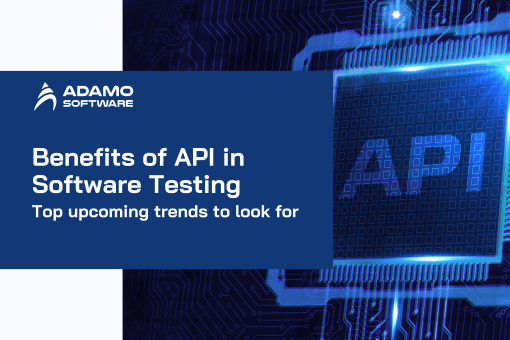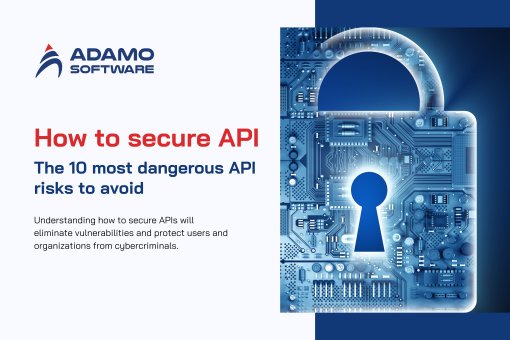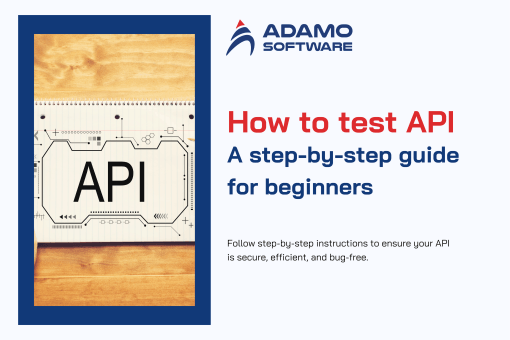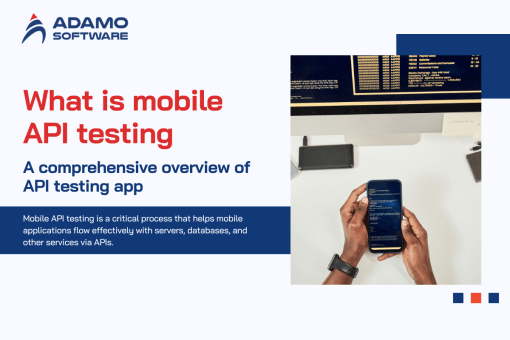What is API integration testing? Key steps to perform it properly
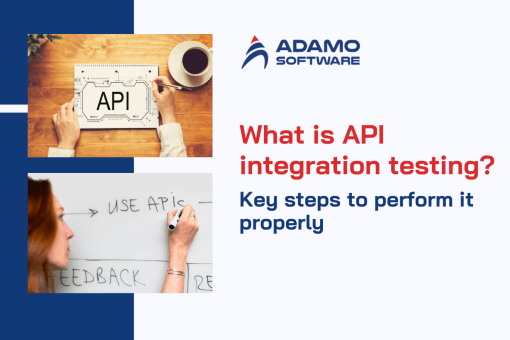
API integration testing is an important function of the software development process that relates to the effectiveness of different APIs. This type of testing validates the behavior of one or more connected APIs when embedded in a system. This way, we can ensure data passes between APIs and the answers to such calls are correct. This is important to the application quality.
API integration testing aims to identify as many problems as possible, including improper data handling, security threats, or low speed. The focus was solely on providing recommendations for separate APIs. Now it is important to know the overall API behavior.
We can get to the endpoint through an effective API integration testing approach. We ensure that whatever is done before and after post-integration is handled. This is not feasible when testing in production.
I. What is API integration testing?
API integration testing confirms that different APIs within a system perform as required when integrated. It differs from other testing approaches regarding the overall confirmation of this communication between these APIs. While unit testing focuses on every API, API integration testing looks at their behavior when input into other structures or programs.
API integration testing enables testers to confirm that data is exchanged in a due manner and the other APIs must understand the responses received. This one aids in recognizing omissions, including misunderstandings, improper structure or data formats, or interface problems.
This testing helps to avoid problems in the general system. The pre-integrated APIs deliver the expected results every time. In a real operational environment, the APIs may fail. And the system’s underlying modules or other components may misfunction or fail to perform specific tasks. This is because the integration testing was inadequately done without proper API integration testing.
II. Why is API integration testing essential?
API integration testing, as an important stage of software development, checks how several APIs can operate simultaneously. In today’s interconnected systems, most applications rely on other related and connected application program interfaces, and things probably go wrong when these interfaces are unwell integrated. When performing API integration testing, developers are sure of the proper working of these APIs in a system increasing its stability.

1. Prevents data loss and errors
API integration testing is necessary because it identifies issues with the data exchange between APIs, … If APIs communicate without the appropriate integration test, the data is not passed correctly, resulting in wrong output or a failed process. Minimizing failure is achieved through testing so that data passed from one system to another is received accurately.
2. Identifies integration issues early
Identification of integration issues is another crucial reason for API integration testing since integration problems detected earlier are less likely to reach the users. APIs can be tested before they go live, which means that even though some developers just deploy an API and start the testing process, these delays can be easily spotted and addressed before they become major issues in the real world.
3. Enhances system security
Security is a highly significant factor of any system using APIs. From the point of security, IT API integration testing guarantees that the integrated APIs adhere to the different security standards and address data safely. This is because, through integration vulnerability testing, developers can avoid some situations like security breakdowns or instances where unauthorized people get access that was not well integrated.
4. Improves system performance
Sound APIs lead to better systems because their integration has been tested properly. API integration testing checks whether the API will handle the expected workload and how APIs behave relative to one another under different circumstances. This guarantees the continued performance of the system is optimized especially as more users or data input is expected.
5. Supports scalability and future growth
What emerged early in the process is that, as applications change, new APIs must be incorporated. Introducing new components in API integration testing becomes easy since it conforms to the enhanced module structure. This way, a company can be confident that the integrated systems can be expanded or redesigned.
In conclusion, considering multiple challenging factors associated with the applications, API integration testing is recognized as the critical process to ensure the stability, security, and performance of modern applications. It ensures that all APIs function coherently to maintain the long-term reliability of the system.
III. Main types of API integration testing
Integration testing on APIs involves some ways that call into concentration distinct API technologies and interaction protocols. Thus, both types focus on different integration cases, to achieve the proper functioning of the APIs integrated. The following are the most common categories of API integration testing.
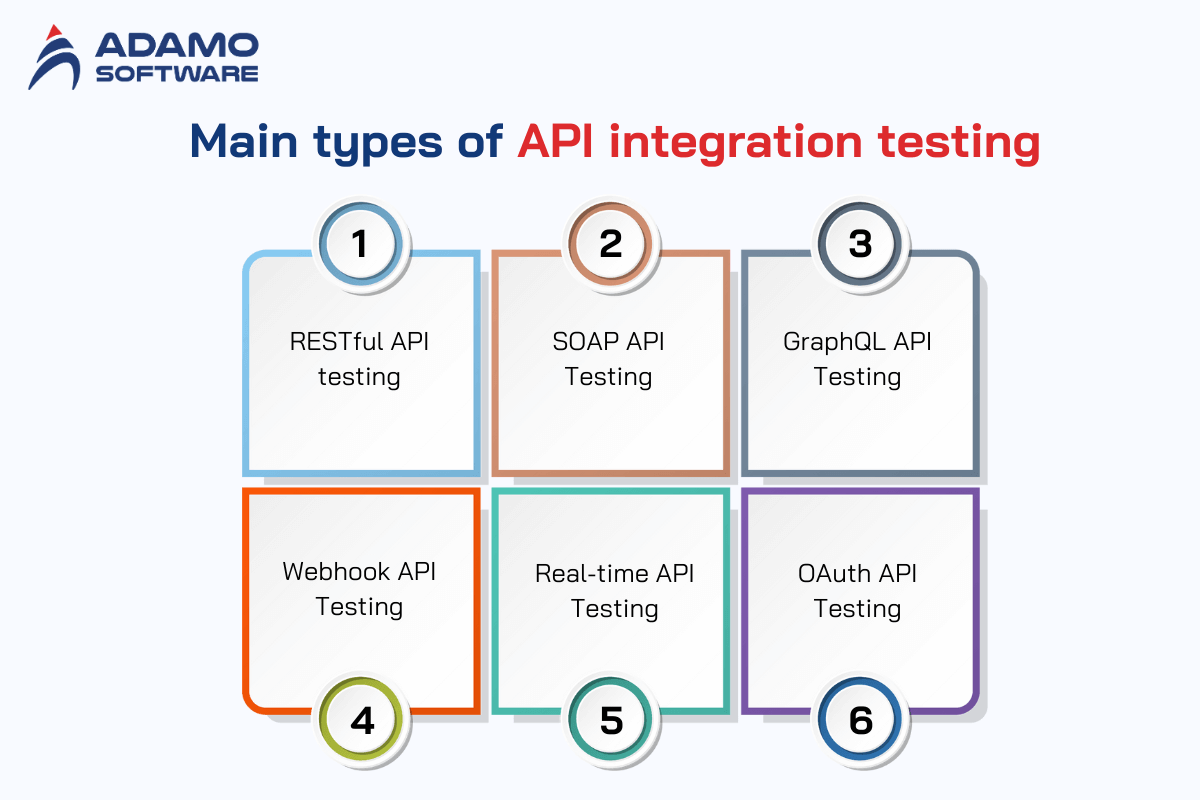
1. RESTful API Testing
RESTful API testing is among the widely used testing types of application programming interfaces. Integrated testing checks how well REST APIs that follow the stateless, client-server architectural style perform as they are implemented.
- Properly POST, GET, and use the HTTP methods (GET, POST, PUT, DELETE).
- Verifying URL references and query strings.
- Which includes testing of response codes and errors.
- Guaranteeing correct data formats such as JSON or XML is essential to maintain modern applications’ stability, security, and performance.
2. SOAP API Testing
SOAP (Simple Object Access Protocol) APIs are thus used in applications that demand organized and secure connections for enterprise applications. SOAP API testing checks whether messages have been swapped in a standard format.
- SOAP checks if WSDL which stands for Web Service Description Language, is correctly formatted regarding API implementation.
- It provides security to all other standards.
- It confirms complex computations with one or more intermediary operations.
3. GraphQL API Testing
GraphQL API testing concentrates on APIs that let clients query data, which is preferable to REST. GraphQL API integration testing tests that the right data is being requested and returned.
- Check on the validity of the structure to query and the variables.
- Can use multiple data fetching in a single request.
- Determining response to array for correct structure.
4. Webhook API Testing
API testing is critical for systems that require webhooks to send real-time notifications. Webhooks enable one system to transfer data to another in real time at certain occurrences.
- Webhook API Testing confirms the object and other related items for an event trigger.
- It alerts over data delivery destination.
- Webhook API testing addresses the issue of data inconsistency when in the process of transmission.
- It examines the usage of retry on failed deliveries that need real-time notifications.
5. Real-Time API Testing
Async APIs are applications applied in situations that need immediate or continuous data exchange, like Messenger and stock exchange applications.
- Real-time testing of the API checks that the system offers a quick response.
- It measures the transmission rate of data.
- It eradicates untidy data with the same data in another format.
- Real-time testing hands over the supported systems at strategic times to verify system synchronization.
- It notes how the system behaves when many clients are present notifications.
6. OAuth API Testing
OAuth API testing is specifically concerned with API that handles authentication and authorization issues. OAuth is a secure way to restrict access to their users’ data without compromising passwords.
- It examines the steps for creating and testing the OAuth token
- Permission and Scope: testing of such access options as allowing read-only, allowing write-only, etc.
- OAuth API testing secures token storage and token exchange.
- It verifies an expiry and a refresh token real-time notification.
These forms of API-integrated testing guarantee that no matter the protocols or use of the API in a larger system, they will interact perfectly. We can keep the system’s integrity, effectiveness, and efficiency through proper API integration testing.
IV. Popular techniques used in API integration testing
In API integration testing several approaches can be used for the overall functionality of the system being tested. They all keep aiming at such aspects as functionality, performance, security, and compliance. Applying these techniques makes it easier for developers to find possible problems so that specific APIs conform to set standards.

1. Mock Testing
Mocking involves mock representations of the API versions to observe the response that the system will produce without even having to invoke the actual API services. It facilitates teams to work with particular functions without interactions with real-world settings.
Key focus:
- Ability to play with API without affecting the live system.
- Mock testing checks for consensus of system behavior without outside APIs.
2. Load Testing
Load testing is designed to decide how certain APIs interconnect and function under varying amounts of traffic. It tests if the API can scale up for the increased traffic without the response time slowing down or the API halting.
Key focus:
- Learning response times under stress.
- Maintaining operational capability for fulfilling incoming traffic in some instances.
- Getting insights about hot spots’ use of fake representations of the API versions.
3. Contract Testing
Contract testing helps to check the contract between two systems for example, between an API provider and an API consumer. It ensures that the API response’s format and interaction pattern are specified in the API contract.
Key focus:
- Checking forms of the request and the response.
- Implementing requirements according to the API standards
- Identifying many breaking changes before they go live makes use of fake representations of the API versions.
4. Security Testing
Security testing is important to identify the security issues related to API integration. It confirms that any data that must be protected is safeguarded and that access to such information is safeguarded.
Key focus:
- Forn tendentious access and data leak.
- Ensuring that correct encryption and authentication have been done.
- Protecting Identity Federation (e.g. fidO) representations of the API versions.
5. End-to-End Testing
System testing emulates actual business processes to verify that all interfaced APIs are fit for purpose across the total value chain. It checks the system’s behavior from inception through the transaction processing.
Key focus:
- Testing of user flows and realistic mode.
- API developed for other APIs to use.
- Data Compare: to affirm that the data are consistent between systems and make representations of the API versions.
6. Regression Testing
Regression testing ensures that new changes to APIs or recent updates do not affect the original functionality previously implemented. It validates the system condition following changes that have been made.
Key focus:
- Recalibration after updates on things that used to integrate with them.
- Researching new problems created by recent shifts.
- Ascertaining whether system integrity is intact after an upgrade is completed after updates.
7. Unique Test
Usually, the goals of unique testing concern isolated testing cases that are particular to the application or the business logic. It assists in confirming deviations from the standard API behavior that may be essential for the system’s success.
Key focus:
- Debugging customer-specific or new business processes.
- Checking specific API behavior only observable on the application.
- Certain unusual circumstances and conditions are provided fortes.
8. Compliance Testing
Compliance testing checks that API integration meets compliance with the set rules and regulations of the industry or certain companies. It confirms that APIs are compliant with the law or some regulation.
Key focus:
- It ensures compliance with set data protection regulations (for example General Data Protection Regulation).
- It has an adequate life cycle, corporate governance, sound economic and proactive environmental policies, and GMP compliance.
- Test of compliance with organizational policies.
9. Performance Testing
System-level performance testing determines the performance of the large, consolidated APIs. It is concerned with response time, system utilization, and the total amount of work passed through a system.
Key focus:
- The normal and intensive API reaction time.
- Confirming the stability of the device during its prolonged usage.
- Making certain that valuable resources are well deployed and that there is maximum downtime.
10. Functional Testing
Functional testing confirms that the APIs work as expected whenever integrating other systems within the applications. It confirms that all the operations of the API respond correctly.
Key focus:
- Functional testing proves concrete API operations as the CRUD operations (Create, Read, Update, and Delete).
- It checks the right way of utilizing data and different methods of analyzing it.
- The features of the API need to be confirmed as suitable for business needs updates.
These techniques are basic in API integration testing to make the API reliable, performant, secure, and compliant. By using these approaches, developers can implement highly reliable and efficient systems fulfilling functional and non-functional requirements.
V. How to test API integration pre- and post-deployment
We must test the APIs after implementing or deploying them and before deploying the APIs. Testing ensures that errors are detected on time and the API has a positive integration with other systems. Both during the design stage and during the testing phase of an API integration, there are rigorous methods that can be employed.
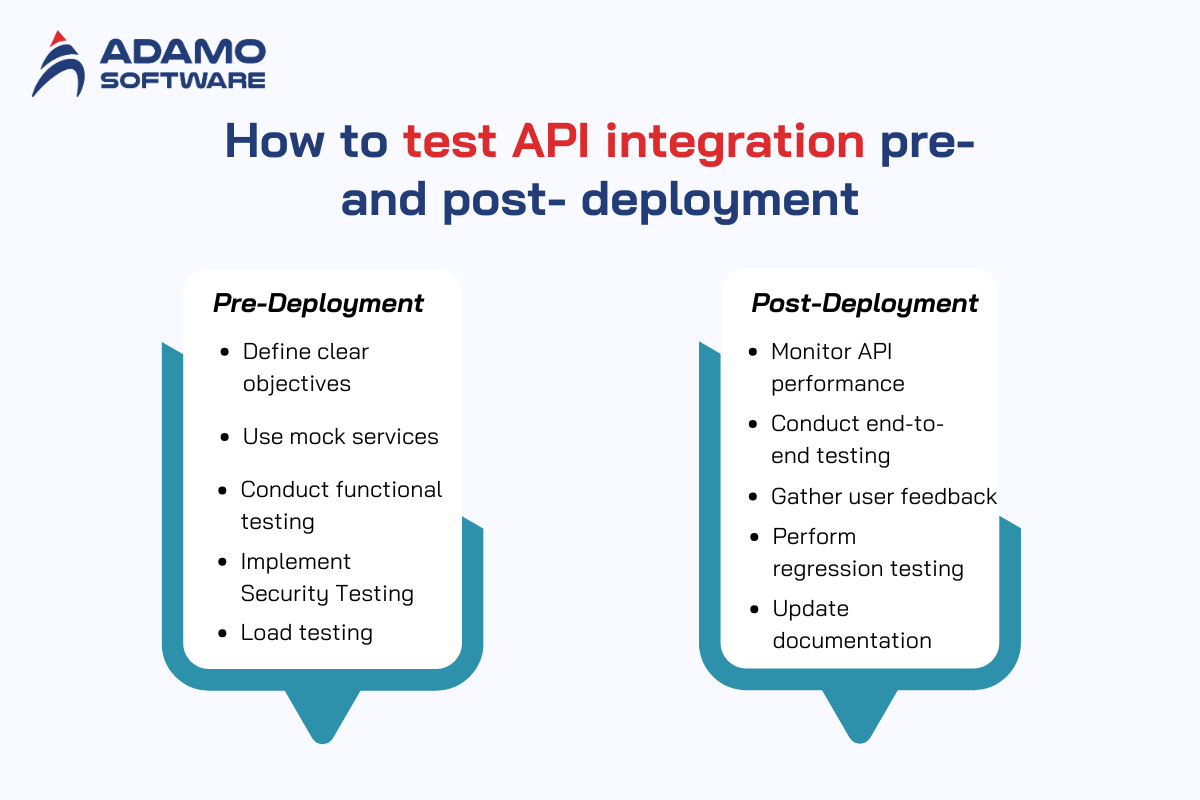
Pre-Deployment Testing
1. Define Clear Objectives
Define the objective of the testing process for the API in the beginning. We need to define the purpose for performance and functions. How testing initiatives can be better linked to business objectives after deployment to ensure everything works as expected.
2. Use Mock Services
Mock Services remove the actual dependencies of a certain tier from the external world by creating mock services that mimic their behavior. This enables teams to apply real use case pressure on the API to determine how it would behave when the other services are ready. This helps to avoid patronizing external APIs. Mock Services facilitate experimental conditions that can be regulated after deployment to ensure everything works as expected.
3. Conduct Functional Testing
Specifically, functional testing is done on the API to ensure it meets all requirements outlined. This involves checking for endpoints, request types, and data handling. Functional testing fosters responses that are expected for diverse inputs after deployment to ensure everything works as expected.
4. Implement Security Testing
To ensure the safety of the API, the following actions are advised to be taken before deploying the API. This includes diagnostics with such problems as authorization vulnerability and data encryption problems. Security testing provides the right level of security to the assets. It assures data security techniques before and after deployment to ensure everything works as expected.
5. Load Testing
Load testing must be done to determine how the API will perform because of the expected users. This testing helps determine the API errors that occur with traffic without reducing its functionality. It also measures the response time of any application under different loads. Load testing shows patterns of capacity planning before and after deployment to ensure everything works as expected.
Post-Deployment Testing
1. Monitor API Performance
An important issue in the case of API is to monitor its performance after deployment. Real-time tools to capture the response time, number of errors, and the dependability of response times.
Key focus:
- Basic Functionality in Production.
- Guaranteeing that everything indeed works well when the API is put into production.
- Preventing and documenting any development of problems as it is monitored.
2. Conduct End-to-End Testing
Do an integrated testing to ensure that the API is working well with all the connected systems. This testing represents real-life implementation and confirms the entire process.
Key focus:
- Matching the API to the complete user experience.
- Coordinating systems and processes to achieve maximum functionality.
3. Gather User Feedback
User feedback should be requested by the API to get suggestions about the API usage. This input is useful regarding API development to find referrals to how the API can be improved and how well it meets the user’s needs.
Key focus:
- How to make an API based on the user’s feedback.
- Adapting delivery depending on the results obtained from API’s performance is crucial.
4. Perform Regression Testing
After every update/fix, perform regression testing to confirm the functionality of previous tests. This testing is essential to avoid creating new problems when making changes.
Key focus:
- Confirming that new updates and changes do not affect the prior functionality of a product will also be involved.
- Maintaining the other stability of the API’s performance is crucial.
5. Update Documentation
Ensure API documentation is updated where changes were made during the testing phase of the API. Such a document should capture the API at the time of documenting it and help developers in using it in the right way.
Key focus:
- Supporting our team with detailed and up-to-date information.
- Providing the necessary information to the users for integration is crucial.
In conclusion, API integration tests before and after the release are crucial to make the application work as expected. By these measures, teams can notice problems early, improve their productivity, and produce a quality product. The utilization of feedback and constant observation enables API to continue being suitable for use in addition to meeting the user’s needs at all times. When API integration testing techniques are properly adopted, one is assured that pre-deployment and post-deployment testing are well covered hence user satisfaction.
Also read: How to test API: A step-by-step guide for beginners
VI. Obstacles and best practices in API integration testing
API integration testing is crucial to check how individual software components interact with each other amid their full implementations. However, there are some challenges that teams encounter in this process. Knowing these risks, along with others and the corresponding best practices can aid organizations in enhancing their testing.
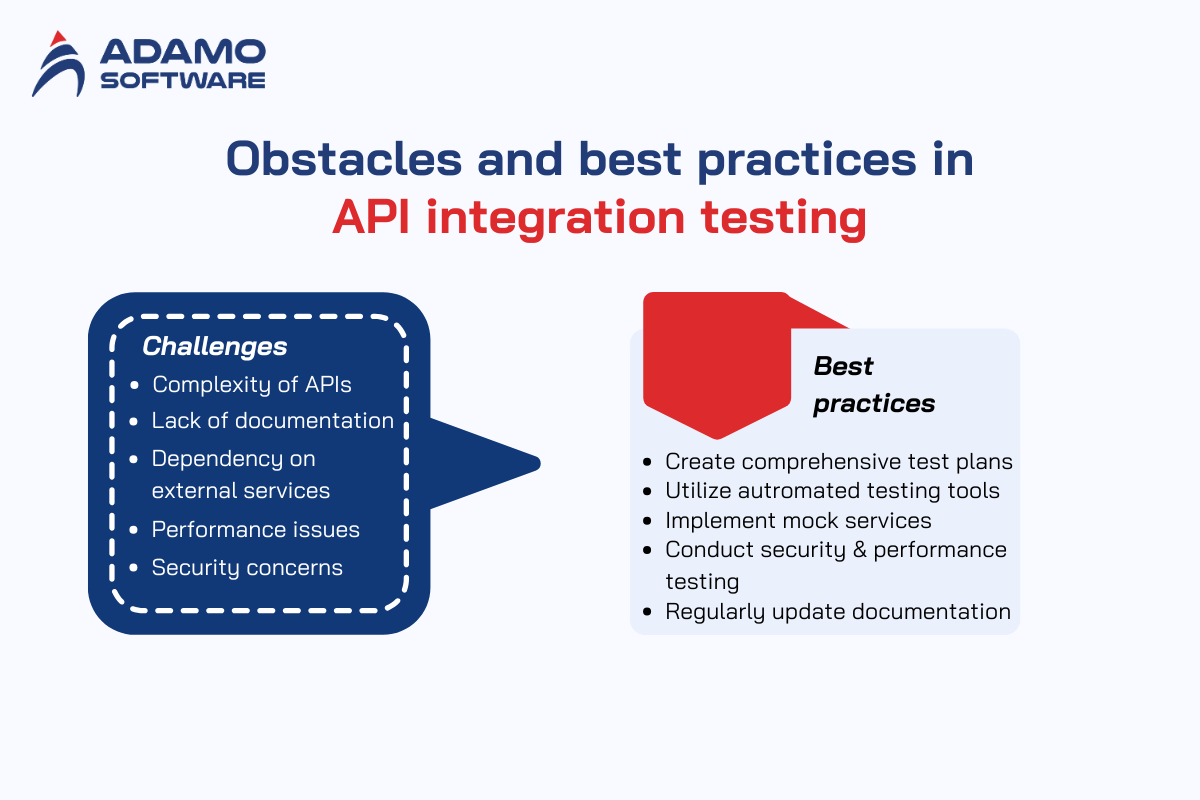
Challenges
1. Complexity of APIs
APIs have complex structure in that there are far-reaching features that may not be easy to get a hold of when conducting tests. In case of changing of API, new endpoint or additional features could complicate it even further. Some multiple versions and dependencies are hard to handle. Broad testing coverage may be missed in some areas.at different software components work together seamlessly.
2. Lack of Documentation
In many cases, the design or documentation of APIs is inadequate; thus, it becomes a challenge for testers to know how to engage with input/output values. This is because poor documentation results in the assumption of wrong details and may also mean that some tests are incomplete. It is difficult to determine all of the endpoints and parameters. Test cases may contain invalid data and information collected sometime back.t different software components work together seamlessly.
3. Dependency on External Services
Most of the APIs depend on external services which could be beyond the control of the team. Any abrupt unavailability or change to these services will affect testing. This results in challenges such as. False negatives due to inconsistency by third-party APIs. Questions about the actual possibility of recreating in test conditions that can take place in real life. These components work together seamlessly.
4. Performance Issues
Performance testing is commonly left out in the integration phase of the system development life cycle. If the API cannot cater to such traffic, it will fail when deployed to the production environment. It can be costly since response time decreases meaning users will not find the page performant as it used to. Needs other resources and more tools for tracking. Different software components work together seamlessly.
5. Security Concerns
It must be understood that APIs as interfaces can be subject to security threats, including data leaks and unauthorized usage. One of the biggest issues when testing is to ensure the API is secure. There is a list of security problems that when not detected early, can leave the system open for exploitation. The duality between product test and security testing is never easy. Ware components work together seamlessly.
Best Practices
1. Create Comprehensive Test Plans
There should be a detailed test plan regarding the API integration testing. It is recommended that this plan provide all the endpoints, parameters, and response results to cover all the aspects. Plans are effective in trying to coordinate testing and determine what needs to be done next.
2. Utilize Automated Testing Tools
A test-case-based and flow-based approach demonstrates that automation can enhance API integration testing. There are interfaces available for testing such as Postman, SoapUI, and JMeter. This reduces efforts by automating the process and enhances the tests done. Feedback on changes made to the code can quickly be done.
3. Implement Mock Services
For dependency issues, mock services come in handy when testing. Stubs can mimic other services to provide better and stabilized services for test facilities. Mock service assists in filtering out problems and confirming interactions. It minimizes the effect brought about by third parties in testing.
4. Conduct Security and Performance Testing
This step includes API security and performance testing. It will also ensure recognition of weaknesses and slow workings and possible advanced screening. It means assuring that APIs are protected against attacks. This step confirms that APIs perform as designed to handle the loads that are expected on an application.
5. Regularly Update Documentation
Maintain the API document up to date if there are some enhancements made during the development and testing phases. The updated documentation helps testers to know how to work with the appropriate API interphase. It promotes efficiency of the process with the integration of developers and testers. And it can be used in future testing.
6. Encourage Team Collaboration
Ensure that developers, testers, and stakeholders work hand in hand when carrying out the API integration testing. Being open also means that if there are any problems they surface early, and everyone knows what’s going on. Team collaboration ensures that the API has a common acceptance of the API objectives and specifications. Therefore, it speeds up the handling of such problems as are pinpointed.
Thus, based on certain directions, API integration testing is not an impossible endeavor insofar as the result is concerned. Complexity, documentation, dependencies, performance, and security can improve the testing processes. Therefore, stressing API integration testing helps to ensure that the systems would function as desired by a user. Implementing such measures can make the API more robust and secure throughout its life cycle.
VII. How to perform API integration testing with Adamo

Adamo is a strong application that makes API integration tests easy to perform. It offers functionalities to ensure the APIs they develop are working, performing efficiently, and secure. The following is a step-by-step approach to the right API integration testing with Adamo.
Step 1: Set Up Your Environment
We still need to create the test environment in Adamo before testing starts in earnest. This entails defining how your API endpoints should be structured or set up and describing the required forms of authentication. Ensure the following points:
- API Endpoints: Specify the URLs of the APIs will be tested.
- Authentication: State any authentication tokens required; if none, state the authentication credentials.
- Testing Framework: Select the right testing framework under Adamo depending on the project type.
Step 2: Define Test Cases
When the environment is set, you should develop specific test cases to show what you expect to prove in the case of API integration testing. Each test case should cover detailed scenarios, such as:
- Positive Test Cases: Confirm that the API response is appropriate for valid input.
- Negative Test Cases: Make API able to respond to a scenario where the request is wrong, improper, or adjudged irrelevant.
- Edge Cases: Verify how the API functions in abnormal conditions, i.e., stress testing.
Step 3: Execute Tests
You can now begin testing your defined test cases by applying the test tools provided under Adamo’s framework. Using Adamo, you can run automated tests, which makes it run faster and increases efficiency. Here’s what to do:
- Run Automated Tests: This means using the various automation features of Adamo to execute your test cases and then keep track of the results.
- Manual Testing: In case of a need to test for more intricate situations that need more judgment from the system perform manual tests.
Step 4: Analyze Test Results
When you perform your tests, examine the data presented to you by Adamo. Search for any discrepancies or any bizarre responsiveness in the API. The following analysis will assist in clearly defining issues that have to be solved. Focus on:
- Response Codes: Whether the HTTP status code returned by API is the correct one or not.
- Response Time: The time taken for API to return a result has to be determined.
- Data Integrity: Make sure that the data that is returned by the server is as required.
Step 5: Report and Fix Issues
In case you live with any problem during API integration testing, be sure to capture it. Reporting tools are provided by Adamos for this purpose so that you can prepare precise and fixed reports that result in such problems. Include information such as:
- Test Case IDs: Mention what test cases failed and show how this impacted the overall results.
- Error Messages: Pass all the error messages given back by API.
- Suggested Fixes: If it is convenient, recommend solutions to the problems.
When these problems are communicated, cooperate with your development unit to eliminate them.
Step 6: Retest
Having made the necessary changes, there will always be the need to retest your API to confirm that all the glitches have been worked out. You should employ the same test cases to ensure these problems are no longer there. This step ensures that the fixes did not bring in other concerns and that the API is content to be released into production.
Using Adamo for API integration testing may be a great way to ease your testing and increase API stability. When put into practice, you have a roadmap that guides the validation of your API functionality, performance, and security. Proper integration testing confirms that the various systems are interoperable and produce a positive user experience. Adamo helps in these testing exercises, making it easier to manage so that the quality of the API integrations is improved.







